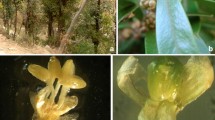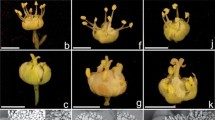Abstract
Exploratory surveys were carried out in the high altitude areas of the northwest Indian Himalaya to analyze and appraise the cytomorphological diversity among the wild flowering plants. During the random exploratory surveys, we found morphological variations in six species viz., Dianthus angulatus Royle ex Benth. (Caryophyllaceae), Geranium wallichianum D. Don ex Sweet (Geraniaceae), Gypsophila cerastioides D. Don (Caryophyllaceae), Impatiens thomsonii Hook.f. (Balsaminaceae), Ranunculus hirtellus Royle (Ranunculaceae) and Thalictrum foetidum L. Variation in the colour of flowers is the main difference in these species. We also investigated chromosome number, male meiosis and pollen fertility in these species. An attempt has also been made to find out the existence of any variation in chromosome number in these floral-morphotypes.



Similar content being viewed by others
References
Amirouche N, Misset MT. Morphological variation and distribution of cytotypes in the diploid-tetraploid complex of the genus Dactylis L. (Poaceae) from Algeria. Plant Syst Evol. 2007;264:157–74.
Belling J. On counting chromosomes in pollen mother cells. Am Nat. 1921;55:573–4.
Bir SS, Thakur HK, Chatha GS. Chromosomal studies in certain members of Ranunculaceae and Mensipermaceae. Proc Indian Sci Congr Assoc. 1987;74:184–5.
Bir SS, Thakur HK. SOCGI plant chromosome number reports-II. J Cytol Genet. 1984;19:114–5.
Chatterjee A, Sharma AK. Chromosome study in Geraniales. Nucleus. 1970;13:179–200.
Chatterjee P. In IOPB chromosome number reports XLVIII. Taxon. 1975;24:367–72.
Cires E, Cuesta C, Peredo EL, Revilla MA, Fernández PJA. Genome size variation and morphological differentiation within Ranunculus parnassifolius group (Ranunculaceae) from calcareous screes in the Northwest of Spain. Plant Syst Evol. 2009;281:193–208.
Cooley AM, Willis JH. Genetic divergence causes parallel evolution of flower color in Chilean Mimulus. New Phytol. 2009;183:729–39.
Davlianidze MT. Chromosome numbers in the representatives of the flora from Georgia. Bot Zhurn (Moscow & Leningrad). 1985;70:698–700.
de Oliveira VM, Forni-Martins ER, Magalhães PM, Alves MN. Chromosomal and morphological studies of diploid and polyploid cytotypes of Stevia rebaudiana (Bertoni) Bertoni (Eupatorieae, Asteraceae). Genet Mol Biol. 2004;27:215–22.
Dobes C, Vitek E. Documented chromosome numbers checklist of austrian vascular plants. Vienna: Verlog des Naturhistorischen Museums Wien; 2000.
Ellison AM, Buckley HL, Miller TE, Gotelli NJ. Morphological variation in Sarracenia purpurea (Sarraceniaceae): geographic, environmental, and taxonomic correlates. Am J Bot. 2004;91:1930–5.
Friesen NV. Chromosome numbers in members of the Ranunculaceae family from Siberia. Bot Žurn (Moscow & Leningrad). 1991;76:905–7.
Gentscheff G. Experimental and caryological investigation of the relationship among the species of the genus Dianthus L. PhD. Thesis, University of Sofia, Sofia; 1937.
Gratani L. Plant phenotypic plasticity in response to environmental factors. Adv Bot. 2014;. doi:10.1155/2014/208747.
Hardy OJ, Vanderhoeven S, De Loose M, Meerts P. Ecological, morphological and allozymic differentiation between diploid and tetraploid knapweeds (Centaurea jacea) from a contact zone in the Belgian Ardenes. New Phytol. 2000;146:281–90.
Jee V, Dhar U, Kachroo P. Chromosome numbers of some alpine-subalpine taxa of Kashmir Himalaya. Herba Hung. 1983;22:23–31.
Karsnikov AA, Schaulo DN. Chromosome numbers of some representatives of families Apiaceae and Ranunculaceae from the South of Siberia. Bot Zhurn (Moscow & Leningrad). 1986;71:116–7.
Keeler KH, Davis GA. Comparison of common cytotypes of Andropogon gerardii (Andropogoneae, Poaceae). Am J Bot. 1999;86:974–9.
Khoshoo TN. Cytology of Impatiens. Curr Sci. 1955;24:423–4.
Khoshoo TN. Cytology of pollen with particular reference to Impatiens and Allieae. Proc Indian Sci Congr Assoc. 1966;63:35–45.
Koul AK, Gohil RN. Cytotaxonomical conspectus of the flora of Kashmir (I). Chromosome numbers of some common plants. Phyton. 1973;15:57–66.
Koutecký P. Morphological and ploidy level variation of Centaruea phrygia agg. (Asteraceae) in the Czech Republic, Slovakia and Ukraine. Folia Geobot. 2007;42:77–102.
Kumar P, Singhal VK, Kaur D. Impaired male meiosis due to irregular synapsis coupled with cytomixis in a new diploid cytotype of Dianthus angulatus (Caryophyllaceae) from Indian cold deserts. Folia Geobot. 2012;47:59–68.
Kumar P. Exploration of cytomorphological diversity in the members of Polypetalae from Lahaul-Spiti and adjoining areas. Ph. D. Thesis, Department of Botany, Punjabi University, Patiala, Punjab, India; 2010.
Kuzmanova B, Evstatieva L, Georgieva S. Chromosome number reports LXXII. Taxon. 1981;30:702.
Langlet OFJ. Contributions to the cytology of Ranunculaceae (Beitrage zur Zytologie der Ranunculazeen). Sven Bot Tidskr. 1927;21:1–17.
Lindner M, Maroschek M, Netherer S, et al. Climate change impacts, adaptive capacity, and vulnerability of European forest ecosystems. For Ecol Manag. 2010;259:698–709.
Löve Á, Löve D. IOPB chromosome number reports LXXV. Taxon. 1982;31:344–60.
Luttikhuizen PC, Stift M, Kuperus P, Van Tienderen PH. Genetic diversity in diploid vs. tetraploid Rorippa amphibian (Brassicaceae). Mol Ecol. 2007;16:3544–53.
Magulaev A Vu. Cytotaxonomic study in some flowering plants of the North Caucasus. Bot Zhurn (Moscow & Leningrad); 1984;69:511–517.
Marks GE. An acetocarmine glycerol jelly for use in pollen fertility counts. Stain Technol. 1954;29:277.
Mehra PN, Remanandan P. Cytology of some West Himalayan Ranunculaceae. Cytologia. 1972;37:281–96.
Mehra PN. Cytology of Himalayan Hardwoods. Calcutta: Sree Saravasty Press Ltd.; 1976.
Menzel A, Sparks TH, Estrella N, et al. European phenological response to climate change matches the warming pattern. Glob Change Biol. 2006;12:1–8.
Nakagawa M. Ploidy, geographical distribution and morphological differentiation of Parasenecio auriculata (Senecioneae, Asteraceae) in Japan. J Plant Res. 2004;119:51–61.
Richter S, Kipfer T, Wohlgemuth T, Guerrero CC, Ghazoul J, Moser B. Phenotypic plasticity facilitates resistance to climate change in a highly variable environment. Oecologia. 2012;169:269–79.
Rostovtseva TS. Chromosome numbers of some species of the family Ranunculaceae II. Bot Zhurn (Moscow & Leningrad). 1981;66:1751–5.
Roy SC, Ghosh S, Chatterjee A. A cytological survey of eastern Himalayan plants. II. Cell Chromosome Res. 1988;11:93–7.
Ruas CF, Aguiar-Perecin MLR. Chromosome evolution in the genus Mikania (Compositae). Am J Bot. 1997;84:1156–63.
Sharma AK. Annual Report (1967–1968) of Cytogenetics Laboratory Department of Botany, University of Calcutta Res Bull. 1970;2:1–50.
Sharma AK, Ghosh P. Cytological studies in Balsaminaceae and Ranunculaceae, Cytogenetics Laboratory Department of Botany, University of Calcutta Res Bull. 1976;3:39.
Singhal VK, Gill BS, Dhaliwal RS. Status of chromosomal diversity in the hardwood tree species of Punjab state. J Cytol Genet. 2007;8:67–83.
Singhal VK, Gill BS, Kumar P. Recent developments in tree cytogenenetics in India. In: Atri NS, Gupta RC, Saggoo MIS, Singhal VK, editors. Germplams diversity and evaluation-angiosperms. Dehra Dun: Bishen Singh Mahendra Pal Singh; 2009. p. 173–228.
Singhal VK. Cytomorphological studies on some members of polypetalae from Northern and Central India. Ph.D. Thesis, Department of Botany, Punjabi University, Patiala; 1982.
Soltis DE, Soltis PS, Schemske DW, Hancock JF, Thompson JN, Husband BC, Judd WS. Autopolyploidy in angiosperms: have we grossly underestimated the number of species? Taxon. 2007;56:13–30.
Španiel S, Marhold K, Hodálová I, Lihová J. Diploid and tetraploid cytotypes of Centaurea stoebe (Asteraceae) in central Europe: morphological differentiation and cytotype distribution patterns. Folia Geobot. 2008;43:131–58.
Svensson S. Chromosome numbers and morphology in the Capsella bursa-pastoris complex (Brassicaceae) in Greece. Willdenowia. 1983;13:267–76.
Thórsson AE, Pálsson S, Sigurgeirsson A, Jónsson AK. Morphological variation among Betula nana (diploid), B. pubescens (tetraploid) and their triploid hybrids in Iceland. Ann Bot. 2007;99:1183–93.
Vitasse Y, Bresson CC, Kremer A, Michalet R, Delzon S. Quantifying phenological plasticity to temperature in two temperate tree species. Funct Ecol. 2010;24:1211–8.
Walther GR, Post E, Convey P, et al. Ecological responses to recent climate change. Nature. 2002;416:389–95.
Warburg EF. Taxonomy and relationship in the Geraniales in the light of their cytology. New Phytol. 1938;37:130–59.
Wellstein C, Chelli S, Campetella G, et al. Intraspecific phenotypic variability of plant functional traits in contrasting mountain grassland habitats. Biodivers Conserv. 2013;22:2353–74.
Wenger-Razine M. In IOPB chromosome number reports XXIII. Taxon. 1969;18:560–2.
Yurtsev BA, Zhukova PG. Chromosome numbers of some plants of the northeastern Yakutia (the drainage of the Indigirka River in its middle reaches). Bot Zhurn (Moscow & Leningrad). 1982;67:778–87.
Acknowledgements
The authors are grateful to the Head, the Department of Botany, Punjabi University, Patiala, and Dr. P. Singh, Director, Botanical Survey of India, Headquarters Kolkata; and the Joint Director Dr. SK Srivastava, NRC, Dehradun for providing necessary laboratory, Herbarium (PUN, BSD), and library facilities. This study was supported by the DRS SAP I, II & III, ASIST programme, and D.S. Kothari Post-Doctoral Fellowship {Award Letter No. F.4-2/2006 (BSR)/13-427/2011(BSR)} to senior author.
Author information
Authors and Affiliations
Corresponding author
Rights and permissions
About this article
Cite this article
Kumar, P., Singhal, V.K. & Singh, H. Intraspecific floral morphotypes in six high altitude perennial herbaceous species from northwest Himalaya: their chromosome counts, meiotic behavior and pollen fertility. Nucleus 61, 35–43 (2018). https://doi.org/10.1007/s13237-017-0211-x
Received:
Accepted:
Published:
Issue Date:
DOI: https://doi.org/10.1007/s13237-017-0211-x




